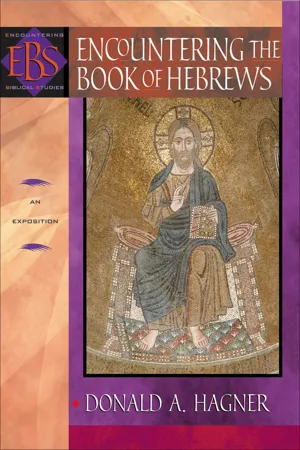
eBook - ePub
Encountering the Book of Hebrews (Encountering Biblical Studies)
An Exposition
- 214 pages
- English
- ePUB (mobile friendly)
- Available on iOS & Android
eBook - ePub
About this book
Although the Book of Hebrews "is not exactly what most of us would regard as a user-friendly book," notes Donald Hagner, "Hebrews has always been popular among Christians." Encountering the Book of Hebrews was written to help students more fully appreciate the complexities of this favorite section of Scripture.
Hagner begins by exploring introductory issues (e.g., historical backgrounds, author, audience, date, purpose, structure, genre) and overarching themes (e.g., heavenly archetypes and earthly copies, the use of the Old Testament, the attitude toward Judaism). The heart of the book then offers a chapter-by-chapter exposition of Hebrews. Unlike commentaries, it does not try to be exhaustive--examining all details and answering all questions--but instead guides students to the issues that are most important for their study of this difficult book. Hagner concludes with a final look at the contribution of Hebrews to the New Testament, New Testament theology, the church, and the individual Christian.
As with other volumes in the Encountering Biblical Studies series, Encountering the Book of Hebrews is designed for classroom use and includes a number of helpful features, including further-reading sections, key terms, chapter objectives, and outlines along with numerous sidebars and illustrations.
Hagner begins by exploring introductory issues (e.g., historical backgrounds, author, audience, date, purpose, structure, genre) and overarching themes (e.g., heavenly archetypes and earthly copies, the use of the Old Testament, the attitude toward Judaism). The heart of the book then offers a chapter-by-chapter exposition of Hebrews. Unlike commentaries, it does not try to be exhaustive--examining all details and answering all questions--but instead guides students to the issues that are most important for their study of this difficult book. Hagner concludes with a final look at the contribution of Hebrews to the New Testament, New Testament theology, the church, and the individual Christian.
As with other volumes in the Encountering Biblical Studies series, Encountering the Book of Hebrews is designed for classroom use and includes a number of helpful features, including further-reading sections, key terms, chapter objectives, and outlines along with numerous sidebars and illustrations.
Frequently asked questions
Yes, you can cancel anytime from the Subscription tab in your account settings on the Perlego website. Your subscription will stay active until the end of your current billing period. Learn how to cancel your subscription.
At the moment all of our mobile-responsive ePub books are available to download via the app. Most of our PDFs are also available to download and we're working on making the final remaining ones downloadable now. Learn more here.
Perlego offers two plans: Essential and Complete
- Essential is ideal for learners and professionals who enjoy exploring a wide range of subjects. Access the Essential Library with 800,000+ trusted titles and best-sellers across business, personal growth, and the humanities. Includes unlimited reading time and Standard Read Aloud voice.
- Complete: Perfect for advanced learners and researchers needing full, unrestricted access. Unlock 1.4M+ books across hundreds of subjects, including academic and specialized titles. The Complete Plan also includes advanced features like Premium Read Aloud and Research Assistant.
We are an online textbook subscription service, where you can get access to an entire online library for less than the price of a single book per month. With over 1 million books across 1000+ topics, we’ve got you covered! Learn more here.
Look out for the read-aloud symbol on your next book to see if you can listen to it. The read-aloud tool reads text aloud for you, highlighting the text as it is being read. You can pause it, speed it up and slow it down. Learn more here.
Yes! You can use the Perlego app on both iOS or Android devices to read anytime, anywhere — even offline. Perfect for commutes or when you’re on the go.
Please note we cannot support devices running on iOS 13 and Android 7 or earlier. Learn more about using the app.
Please note we cannot support devices running on iOS 13 and Android 7 or earlier. Learn more about using the app.
Yes, you can access Encountering the Book of Hebrews (Encountering Biblical Studies) by Donald A. Hagner in PDF and/or ePUB format, as well as other popular books in Theology & Religion & Biblical Criticism & Interpretation. We have over one million books available in our catalogue for you to explore.
Information
1 The Most Important Thing God Ever Said
The first paragraph of the Epistle gives a summary view of its main subject, the finality of the absolute Revelation in Christ as contrasted with the preparatory revelation under the Old Covenant.
—B. F. Westcott, Commentary on the Epistle to the Hebrews

Supplemental Reading
Outline
• Opening Statement (1:1–2a)
• Seven Phrases Describing the Son (1:2b–3)
Phrase 1
Phrase 2
Phrase 3
Phrase 4
Phrase 5
Phrase 6
Phrase 7
• The Superiority of Christ to the Angels (1:4)
• Chain of Seven Old Testament Quotations (1:5–13)
Quotations 1 and 2
Quotations 3 and 4
Quotation 5
Quotation 6
Quotation 7
• The Role of Angels (1:14)
Objectives
- List seven descriptors of the Son.
- Evaluate the proper role of angels.
- Describe the centrality of Christ to Christianity’s faith and worship.
Ours is a day of many voices saying many things. Nowhere is this truer than in the area of religious claims. Bits and pieces of value and truth seem to be in many places. But is there any comprehensive, unifying truth in the realm of religion that deserves being called truth with a capital Τ? Although it is somewhat unfashionable to talk about truth in an absolute sense, Christians will make such an affirmation and point to Jesus Christ. He alone is the final and full Truth. In him, God has spoken definitively, and has said, and done, the most important thing ever. We will do well, therefore, to pay close attention to the matters that lie before us in these opening lines.

The Colosseum in Rome; the church in Rome was the likely recipient of the Book of Hebrews
Opening Statement (1:1–2a)
The Book of Hebrews begins with just such an unqualified affirmation of the final truth of Jesus Christ. With eloquence impossible to reproduce in English translation, the author’s first words indicate a sense of the fragmentary and varied ways that God had spoken in the past to his people. The whole of God’s work with Israel is in view. Implicit in this statement is the conviction that the Old Testament Scriptures do not in themselves provide a unified and conclusive word from God. God has spoken often and much through prophetically inspired individuals in the past; that is clear and gladly affirmed. But where all of this ultimately was to lead remained unclear.
In the first part of verse 2 we encounter the primary assertion of the author: “But in these last days he has spoken to us by a Son.” Oddly enough, the name “Jesus” does not occur in Hebrews until 2:9. But despite this, and despite the lack of the definite article before “Son” in the Greek of verse 2, no one in the early church would have had any uncertainty concerning the identity of the one referred to here as the Son. The unique status of the Son is the focus of the remainder of the chapter.
In its contrast with the words in verse 1, the statement in verse 2 indicates that the sending of God’s Son is the pivotal point in the accomplishment of salvation, and that this event holds the interpretive key that unlocks the meaning of all that preceded in the history of God’s dealings with his people. Indeed, this insight is a part of the illumination that comes with the end of the age. The coming of God’s Son is eschatological and definitive: “in these last days.” A turning point in the ages has been reached (“he has appeared once for all at the end of the ages” [9:26]). This means that the author, in agreement with all of early Christianity, believed that the present age was in some sense the beginning of the end of time, a unique era in which God poured out gifts upon his people that were anticipations of the age to come (see 6:5; 12:22).

The interior of the Colosseum
Seven Phrases Describing the Son (1:2b–3)
What is now said of the Son is nothing short of astounding. The weighty phrases point to a unique majesty resulting from a unique relationship to the Father. It is no coincidence that seven phrases are used and that seven Old Testament quotations follow in the first chapter, since seven was regarded as the number of fullness or perfection.
Phrase 1
The Son is first described as the “heir of all things.” Inheritance in Israel was the right of the firstborn son. As the heir, all things already belong to the Son in principle, just as they will actually and finally be his at the end. The emphasis in the present passage is upon the future time when Christ will be recognized and acknowledged as Lord of all (cf. Phil 2:10–11). All things were created “for him,” as another New Testament writer puts it (Col 1:16). There is nothing that will not finally belong to him in the fullest sense.
Seven Phrases Describing the Son in Hebrews 1:2b–3
- “appointed heir of all things”
- “through whom he made the universe”
- “the radiance of God’s glory”
- “the exact representation of his being”
- “sustaining all things by his powerful word”
- “provided purification for sins”
- “sat down at the right hand of the Majesty in heaven”
Only the sixth item, the providing of purification for sins, finds a parallel among mortals, in the high priests, yet even here it is only the work of the Son that proves finally effective. All else points to the deity of the Son.
Wisdom Christology
| | ||
| Hebrews | Proverbs | Wisdom of Solomon |
| | ||
| 1:2 “through whom he made the universe” | 8:27–30 “I [wisdom] was there when he set the heavens in place . . . marked out the horizon . . . established the clouds . . . fixed the fountains of the deep . . . gave the sea its boundary . . . marked out the foundations of the earth. . . . I was the craftsman at his side.” | 9:2, 9 “By your wisdom [you] have formed humankind.” “Wisdom . . . was present when you made the world.” |
| | ||
| 1:3 “the radiance of God’s glory” | 7:25–26 “She [wisdom] . . . is a pure emanation of the glory of the Almighty.” “She is a reflection of eternal light.” | |
| | ||
| 1:3 “the exact representation of his being” | 7:25–26 “She is a breath of the power of God . . . a spotless mirror of the working of God and an image of his goodness.” | |
| | ||
| Further reading: | ||
Phrase 2
Furthermore, the Son was instrumental in the creation of all that exists (for “universe” the Greek has literally “the ages”). The key role of the Son in creation is affirmed by Paul (1 Cor 8:6; Col 1:16) and the Gospel of John (Jn 1:3). Probably underlying this idea is a wisdom Christology, which identifies Christ with the personified Wisdom who speaks in Proverbs 8:27–31 and in the similar material in chapter 9 of the apocryphal writing Wisdom of Solomon (see the sidebar “Wisdom Christology”). The Son thus belongs with God as the fountainhead of creation and is not to be ranked with the creation as a created being. There is nothing that does not owe its existence to the creating work of the Son. All is his, therefore, by right of that creation.
Phrase 3
The first clause of verse 3 states that the Son uniquely manifests “the glory of God.” The Greek word apaugasma, translated in the NIV as “radiance” (better than the RSV and NRSV translations, which use the idea of “reflection”), is found in the Greek New ...
Table of contents
- Cover
- Series Page
- Title Page
- Copyright Page
- Contents in Brief
- Contents
- List of Sidebars
- Editor’s Preface
- Publisher’s Preface
- To the Student
- Author’s Preface
- Abbreviations
- Introduction
- 1. The Most Important Thing God Ever Said
- 2. The Full Humanity of the Son of God
- 3. Christ Is Superior to Moses
- 4. The Remaining Promise of Rest
- 5. The High Priesthood of Christ
- 6. Apostasy and Divine Faithfulness
- 7. The Priesthood of Melchizedek
- 8. The New and Better Covenant
- 9. Christ the Definitive Sacrifice
- 10A. Moving from the Imperfect to the Perfect: 10:1–18
- 10B. Faithfulness, Apostasy, and Endurance: 10:19–39
- 11. Supreme Examples of Faith
- 12. A Call to Faithfulness
- 13. Concluding Exhortations and Benediction
- Conclusion: The Place of Hebrews in the New Testament and Its Contribution to Theology, the Church, and the Christian
- Excursus: The Entry of Hebrews into the New Testament Canon
- Select Bibliography
- Glossary
- Scripture Index
- Subject Index
- Notes